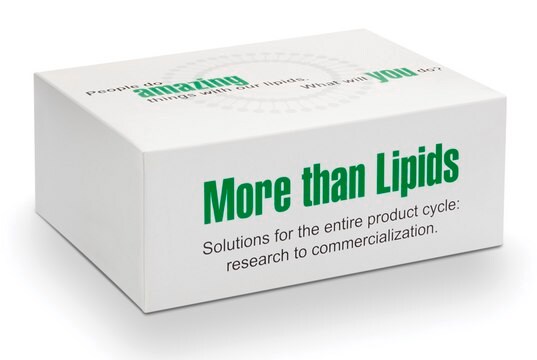855676C
Avanti
17:0 Lyso PC
1-heptadecanoyl-2-hydroxy-sn-glycero-3-phosphocholine, chloroform
Sinonimo/i:
1-heptadecanoyl-sn-glycero-3-phosphocholine; PC(17:0/0:0)
About This Item
Prodotti consigliati
Saggio
>99% (LPC; may contain up to 10% of the 2-LPC isomer, TLC)
Stato
liquid
Confezionamento
pkg of 1 × 2.5 mL (855676C-25mg)
pkg of 2 × 4 mL (855676C-200mg)
Produttore/marchio commerciale
Avanti Research™ - A Croda Brand 855676C
Concentrazione
10 mg/mL (855676C-25mg)
25 mg/mL (855676C-200mg)
Condizioni di spedizione
dry ice
Temperatura di conservazione
−20°C
InChI
1S/C25H52NO7P/c1-5-6-7-8-9-10-11-12-13-14-15-16-17-18-19-25(28)31-22-24(27)23-33-34(29,30)32-21-20-26(2,3)4/h24,27H,5-23H2,1-4H3/t24-/m1/s1
SRRQPVVYXBTRQK-XMMPIXPASA-N
Applicazioni
Confezionamento
Note legali
Avvertenze
Danger
Indicazioni di pericolo
Classi di pericolo
Acute Tox. 3 Inhalation - Acute Tox. 4 Oral - Aquatic Chronic 3 - Carc. 2 - Eye Irrit. 2 - Repr. 2 - Skin Irrit. 2 - STOT RE 1 - STOT SE 3
Organi bersaglio
Central nervous system, Liver,Kidney
Classe di pericolosità dell'acqua (WGK)
WGK 3
Scegli una delle versioni più recenti:
Certificati d'analisi (COA)
Ci dispiace, ma al momento non ci sono COA disponibili online per questo prodotto.
Se ti serve aiuto, non esitare a contattarci Servizio Clienti
Possiedi già questo prodotto?
I documenti relativi ai prodotti acquistati recentemente sono disponibili nell’Archivio dei documenti.
Il team dei nostri ricercatori vanta grande esperienza in tutte le aree della ricerca quali Life Science, scienza dei materiali, sintesi chimica, cromatografia, discipline analitiche, ecc..
Contatta l'Assistenza Tecnica.










